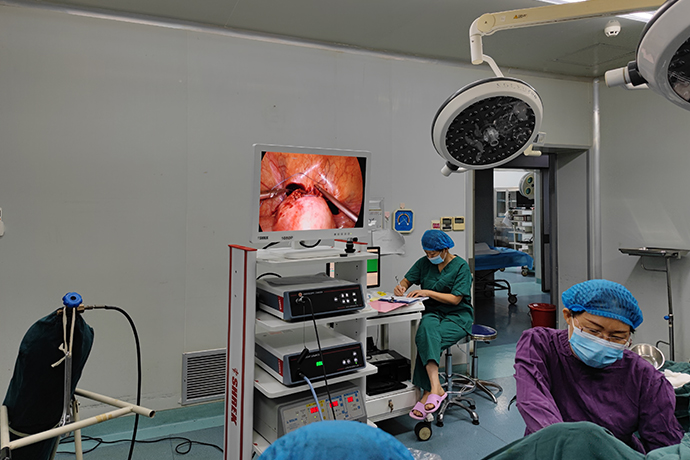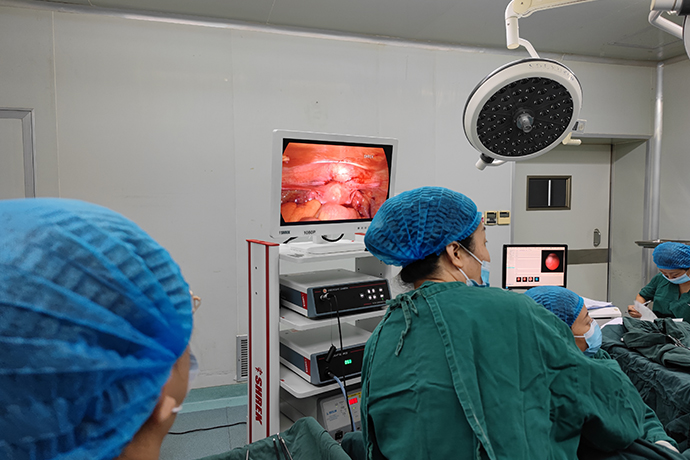【Gynecological Laparoscopy】Resection of Fallopian Tube Pregnancy
Release time: 14 Sep 2021 Author:Shrek
Indications
1. No birth requirements.
2. Tubal pregnancy rupture type, severe fallopian tube appearance damage, massive hemorrhage in the abdominal cavity, shock, unable to repair or unable to restore function after repair, recurrent ectopic pregnancy and tubal tuberculosis.
3. Conservative treatment failure.
4. There are obviously chronic fallopian tube inflammations that may be pregnant again.

Surgical steps and techniques
1. Aspirate the pelvic hemorrhage, lift the diseased fallopian tube, clamp the bleeding site, and temporarily control the bleeding.
2. Use a unipolar or bipolar electrocoagulation hook to coagulate the affected side of the mesangial tube, and perform electrocoagulation at the junction of the part to be removed and the normal tissue one by one, including the mesangial tube and the corner of the uterus near the terminal.
3. The wound was treated with electrocoagulation to stop bleeding again.
4. Smaller specimens can be taken out through a 10mm sleeve sheath, and larger ones can be packed in a specimen bag and taken out in batches. The taken out specimens should be carefully checked for pregnancy tissue.
Intraoperative risks and prevention
1. Affect ovarian function and make the ovaries swell up in response to gonadotropins. Precautionary measures: As close as possible to the fallopian tube for electrocision, the time of electrocoagulation should be appropriate.
2. In the case of secondary abdominal pregnancy, there is still a risk of secondary abdominal pregnancy after the removal of the affected fallopian tube. When flushing the pelvic and abdominal cavity, the broken cells in the pelvic and abdominal hemorrhage may increase. The flow is easy to spread to other parts of the abdominal cavity for planting. Preventive measures: try to flush the pelvic and abdominal cavity as little as possible before removing the affected fallopian tube.
Precautions after operation
1. Although persistent ectopic pregnancy often occurs after conservative surgery, there is still a risk of persistent ectopic pregnancy after salpingectomy, mainly including dry tubal pregnancy abortion secondary abdominal pregnancy, and Clamping the fallopian tube during the resection resulted in the fragmentation of the villi and the secondary implantation in the abdominal cavity.
2. Routine monitoring of blood B-hCG level after operation (on the first day after operation, once a week after discharge until blood B-hCG is normal), it is helpful to timely detect persistent ectopic pregnancy and deal with it early.

1. No birth requirements.
2. Tubal pregnancy rupture type, severe fallopian tube appearance damage, massive hemorrhage in the abdominal cavity, shock, unable to repair or unable to restore function after repair, recurrent ectopic pregnancy and tubal tuberculosis.
3. Conservative treatment failure.
4. There are obviously chronic fallopian tube inflammations that may be pregnant again.

Surgical steps and techniques
1. Aspirate the pelvic hemorrhage, lift the diseased fallopian tube, clamp the bleeding site, and temporarily control the bleeding.
2. Use a unipolar or bipolar electrocoagulation hook to coagulate the affected side of the mesangial tube, and perform electrocoagulation at the junction of the part to be removed and the normal tissue one by one, including the mesangial tube and the corner of the uterus near the terminal.
3. The wound was treated with electrocoagulation to stop bleeding again.
4. Smaller specimens can be taken out through a 10mm sleeve sheath, and larger ones can be packed in a specimen bag and taken out in batches. The taken out specimens should be carefully checked for pregnancy tissue.
Intraoperative risks and prevention
1. Affect ovarian function and make the ovaries swell up in response to gonadotropins. Precautionary measures: As close as possible to the fallopian tube for electrocision, the time of electrocoagulation should be appropriate.
2. In the case of secondary abdominal pregnancy, there is still a risk of secondary abdominal pregnancy after the removal of the affected fallopian tube. When flushing the pelvic and abdominal cavity, the broken cells in the pelvic and abdominal hemorrhage may increase. The flow is easy to spread to other parts of the abdominal cavity for planting. Preventive measures: try to flush the pelvic and abdominal cavity as little as possible before removing the affected fallopian tube.
Precautions after operation
1. Although persistent ectopic pregnancy often occurs after conservative surgery, there is still a risk of persistent ectopic pregnancy after salpingectomy, mainly including dry tubal pregnancy abortion secondary abdominal pregnancy, and Clamping the fallopian tube during the resection resulted in the fragmentation of the villi and the secondary implantation in the abdominal cavity.
2. Routine monitoring of blood B-hCG level after operation (on the first day after operation, once a week after discharge until blood B-hCG is normal), it is helpful to timely detect persistent ectopic pregnancy and deal with it early.

- Recommended news
- 【General Surgery Laparoscopy】Cholecystectomy
- Surgery Steps of Hysteroscopy for Intrauterine Adhesion
- [ENT Surgery: Nasal Endoscopy] Endoscopic Treatment of Nasal Polyps
- [Otolaryngology Nasal Endoscopy] Methods and Precautions for Nasal Bleeding Control under Nasal Endoscopy
- [Orthopedic UBE Section] Four Years of Evolution of UBE Technology: From Lumbar Fusion to the "Forbidden Zone" of Thoracic and Cervical Spine, and the Unignorable "Hydraulic Pressure Crisis"